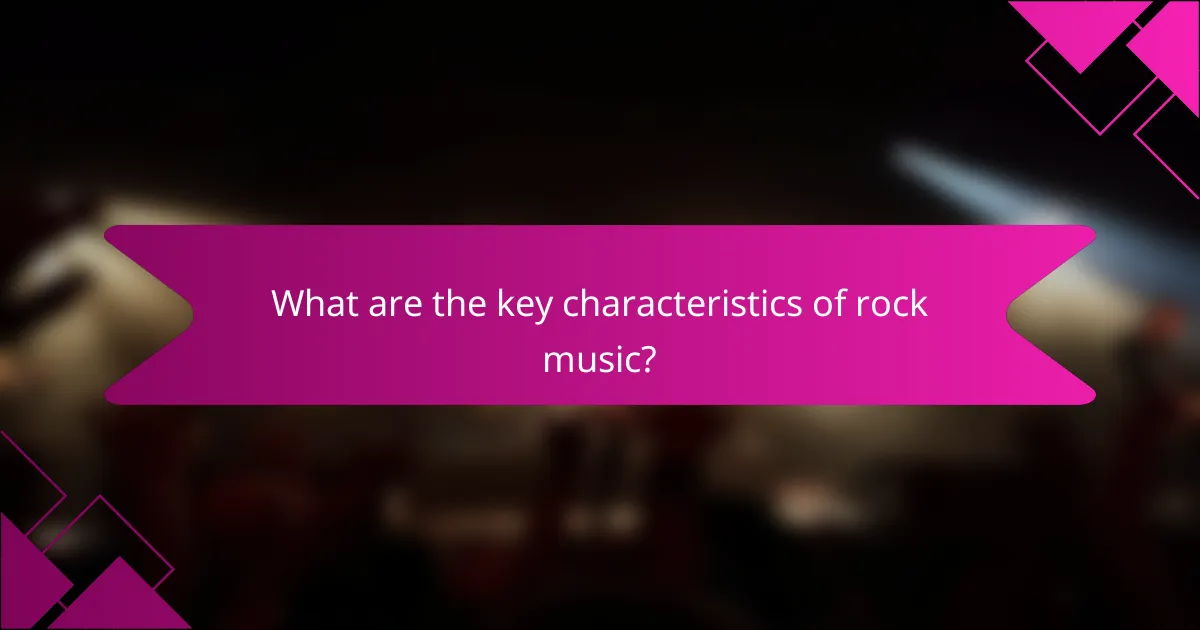Rock music is defined by its powerful guitar-driven sound and a wide array of lyrical themes, often delving into topics like rebellion, love, and social issues. Over the decades, it has evolved into numerous sub-genres, including classic rock, punk rock, and heavy metal, each with its unique characteristics and cultural influences. This evolution reflects broader cultural shifts and technological advancements, creating a diverse landscape that continues to inspire artists today.

What are the key characteristics of rock music?
Rock music is characterized by its strong guitar-driven sound, diverse lyrical themes, and a variety of sub-genres. It typically features a prominent electric guitar, a strong backbeat, and often explores themes of rebellion, love, and social issues.
Guitar-driven sound
The guitar-driven sound is the hallmark of rock music, with electric guitars often taking center stage. This sound is created through the use of distortion, power chords, and various playing techniques like fingerpicking and strumming. Bands may use a combination of rhythm and lead guitars to create a rich, layered audio experience.
Iconic rock songs often feature memorable guitar riffs that define the track. For example, songs like “Smoke on the Water” by Deep Purple and “Sweet Child O’ Mine” by Guns N’ Roses showcase how a strong guitar presence can elevate a song’s impact.
Lyrical themes of rebellion
Lyrical themes of rebellion are prevalent in rock music, reflecting a desire for freedom and social change. Many rock songs address issues such as political unrest, personal struggles, and the quest for identity. This rebellious spirit resonates with listeners, often inspiring them to challenge societal norms.
Classic anthems like “Revolution” by The Beatles and “Fight the Power” by Public Enemy exemplify how rock music can serve as a voice for dissent and empowerment. These themes continue to evolve, addressing contemporary issues while maintaining their core message of defiance.
Influence of blues and jazz
The influence of blues and jazz is foundational to rock music, shaping its sound and structure. Many rock musicians draw from blues scales and jazz improvisation techniques, creating a unique blend that enhances emotional expression. This connection is evident in the use of 12-bar blues progressions and jazz-inspired solos.
Artists like Eric Clapton and Jimi Hendrix exemplify this fusion, incorporating elements of both genres into their work. The improvisational aspect of jazz also allows rock musicians to experiment during live performances, adding spontaneity to their shows.
Instrumentation and arrangement
Instrumentation in rock music typically includes electric guitars, bass guitars, drums, and keyboards. The arrangement often features a clear structure, with verses, choruses, and bridges that create a dynamic flow. This setup allows for both melodic and rhythmic complexity, appealing to a wide audience.
Some sub-genres, like progressive rock, may incorporate additional instruments such as synthesizers and orchestral elements, expanding the sonic palette. Bands like Pink Floyd and Yes are known for their elaborate arrangements that push the boundaries of traditional rock music.
Performance style
Performance style in rock music is often characterized by high energy and theatricality. Musicians typically engage with the audience through dynamic stage presence, showcasing their skills and charisma. This connection enhances the overall experience, making live shows memorable events.
Rock performances may include elaborate light shows, pyrotechnics, and audience participation, creating an immersive atmosphere. Iconic performances, such as those by Queen at Live Aid, demonstrate how a powerful stage presence can elevate a band’s impact and legacy in the music world.

How has rock music evolved over the decades?
Rock music has transformed significantly since its inception, reflecting cultural shifts and technological advancements. Each decade brought new sounds, styles, and lyrical themes, leading to a rich tapestry of sub-genres that continue to influence artists today.
1960s: Birth of rock and roll
The 1960s marked the emergence of rock and roll, characterized by its energetic guitar-driven sound and catchy melodies. Pioneers like Elvis Presley and Chuck Berry fused rhythm and blues with country influences, creating a genre that resonated with youth culture.
This decade also saw the rise of iconic bands such as The Beatles and The Rolling Stones, who expanded rock’s popularity globally. Their innovative approaches to songwriting and performance set the stage for future generations of musicians.
1970s: Rise of sub-genres
The 1970s witnessed the diversification of rock music into various sub-genres, including hard rock, progressive rock, and punk rock. Bands like Led Zeppelin and Pink Floyd pushed musical boundaries, while the emergence of punk, led by groups like The Ramones, emphasized raw energy and anti-establishment themes.
This era also introduced the concept of the rock album as an artistic statement, with albums often featuring cohesive themes and elaborate production techniques. The variety of sounds and styles during this decade laid the groundwork for rock’s evolution in the years to come.
1980s: Glam and punk influences
The 1980s brought a blend of glam rock and punk influences, resulting in a vibrant and visually striking music scene. Glam rock bands like Mötley Crüe and Poison embraced flamboyant aesthetics and catchy hooks, while punk continued to thrive with bands like The Clash and Dead Kennedys challenging societal norms.
This decade also saw the rise of music videos, particularly on MTV, which transformed how artists promoted their music. The visual aspect became as important as the sound, leading to iconic performances and memorable imagery.
1990s: Grunge and alternative rock
The 1990s were dominated by grunge and alternative rock, with bands like Nirvana and Pearl Jam bringing a raw, introspective sound to the forefront. Grunge’s heavy guitar riffs and angst-filled lyrics resonated with a generation disillusioned by mainstream culture.
This decade also saw the emergence of diverse sub-genres, including indie rock and nu-metal, as artists experimented with different styles and influences. The rise of alternative rock radio stations helped to popularize these new sounds and broaden the rock audience.
2000s: Digital transformation
The 2000s marked a significant digital transformation in rock music, with the rise of the internet changing how music was distributed and consumed. Bands like The Strokes and Arctic Monkeys utilized online platforms to reach audiences, often bypassing traditional record labels.
This era also saw the blending of rock with other genres, such as electronic and hip-hop, leading to innovative sounds. The accessibility of digital recording technology allowed more artists to create and share their music, resulting in a diverse and dynamic rock landscape.

What are the major sub-genres of rock music?
The major sub-genres of rock music include classic rock, punk rock, heavy metal, indie rock, and progressive rock. Each sub-genre has distinct characteristics, musical styles, and cultural influences that contribute to the rich diversity of rock music.
Classic rock
Classic rock is characterized by its roots in the rock music of the 1960s to the 1980s, featuring iconic bands like The Rolling Stones, Led Zeppelin, and The Who. This sub-genre often emphasizes guitar-driven melodies and anthemic choruses, making it a staple on radio stations and playlists.
Classic rock typically includes elements of blues, folk, and country, creating a sound that resonates with a wide audience. Key tracks often showcase powerful guitar solos and relatable lyrics, appealing to both nostalgia and contemporary listeners.
Punk rock
Punk rock emerged in the mid-1970s as a reaction against mainstream music, emphasizing simplicity, speed, and raw energy. Bands like The Ramones, Sex Pistols, and The Clash defined this genre with their straightforward song structures and often politically charged lyrics.
This sub-genre is known for its DIY ethic, encouraging independent production and distribution. Punk rock’s influence can be seen in various music scenes worldwide, promoting a sense of rebellion and authenticity among fans and musicians alike.
Heavy metal
Heavy metal is characterized by its loud, aggressive sound, featuring distorted guitars, powerful vocals, and complex song structures. Bands such as Black Sabbath, Metallica, and Iron Maiden are pivotal in shaping this genre, which often explores themes of fantasy, mythology, and personal struggle.
Heavy metal encompasses various styles, including thrash, doom, and power metal, each with unique characteristics. The genre has a dedicated fan base and often includes elaborate live performances, showcasing musicianship and theatricality.
Indie rock
Indie rock represents a diverse range of sounds that emerged from independent music scenes, typically characterized by a more experimental approach. Bands like Arcade Fire, The Strokes, and Death Cab for Cutie exemplify this genre, which often blends elements from various musical styles.
Indie rock is known for its emphasis on artistic expression and authenticity, often eschewing commercial pressures. This sub-genre has gained significant popularity, particularly in the 2000s, thanks to the rise of digital distribution and social media, allowing artists to reach wider audiences.
Progressive rock
Progressive rock, or prog rock, is known for its complex compositions, intricate instrumentation, and conceptual themes. Bands like Pink Floyd, Yes, and Genesis are key figures in this genre, often incorporating elements from classical music and jazz.
This sub-genre frequently features lengthy tracks, elaborate arrangements, and storytelling lyrics, creating immersive listening experiences. Progressive rock appeals to listeners who appreciate musical experimentation and thematic depth, making it a unique branch of rock music.

How do rock music themes resonate with audiences in the US?
Rock music themes resonate deeply with US audiences by reflecting their experiences, emotions, and societal issues. This genre often serves as a voice for the youth, addressing personal struggles and broader cultural narratives.
Social and political commentary
Rock music frequently acts as a platform for social and political commentary, allowing artists to express dissent and advocate for change. Lyrics often tackle issues such as inequality, war, and civil rights, resonating with listeners who share similar frustrations or aspirations.
For example, songs from the 1960s and 1970s, like those by Bob Dylan and Creedence Clearwater Revival, addressed the Vietnam War and civil rights movements, capturing the zeitgeist of their times. More contemporary artists continue this tradition, using their music to comment on current events and societal challenges.
When exploring rock music’s social and political themes, consider how the context of the era influences the message. Audiences often connect more deeply with songs that reflect their own experiences or the struggles of their communities, making the genre a powerful tool for activism and awareness.
